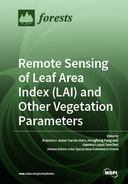Explore

Remote Sensing of Leaf Area Index (LAI) and Other Vegetation Parameters
0 Ungluers have
Faved this Work
Login to Fave
Monitoring of vegetation structure and functioning is critical to modeling terrestrial ecosystems and energy cycles. In particular, leaf area index (LAI) is an important structural property of vegetation used in many land surface vegetation, climate, and crop production models. Canopy structure (LAI, fCover, plant height, and biomass) and biochemical parameters (leaf pigmentation and water content) directly influence the radiative transfer process of sunlight in vegetation, determining the amount of radiation measured by passive sensors in the visible and infrared portions of the electromagnetic spectrum. Optical remote sensing (RS) methods build relationships exploiting in situ measurements and/or as outputs of physical canopy radiative transfer models. The increased availability of passive (radar and LiDAR) RS data has fostered their use in many applications for the analysis of land surface properties and processes, thanks also to their insensitivity to weather conditions and the capability to exploit rich structural and textural information. Data fusion and multi-sensor integration techniques are pressing topics to fully exploit the information conveyed by both optical and microwave bands.
This book is included in DOAB.
Why read this book? Have your say.
You must be logged in to comment.
Rights Information
Are you the author or publisher of this work? If so, you can claim it as yours by registering as an Unglue.it rights holder.Downloads
This work has been downloaded 323 times via unglue.it ebook links.
- 59 - pdf (CC BY-NC-ND) at Unglue.it.
Keywords
- 3D point cloud
- aboveground biomass
- adaptive threshold
- allometric scaling and resource limitation
- altitude
- artificial neural network
- automated classification
- BAAPA
- Biomass
- Brazilian Amazon
- canopy closure
- canopy gap fraction
- chlorophyll fluorescence (ChlF)
- clumping index
- conifer forest
- consistency
- density-based clustering
- digital aerial photograph
- downscaling
- drought
- Epic
- European beech
- Evaluation
- farm types
- fixed tree window size
- Forest
- forest above ground biomass (AGB)
- forest aboveground biomass
- forest degradation
- forest inventory
- forests biomass
- Fraction of Photosynthetically Active Radiation absorbed by vegetation (FPAR)
- geographic information system
- GLAS
- Global Positioning System
- hemispherical sky-oriented photo
- HemiView
- household survey
- LAI
- leaf area index
- leaf area index (LAI)
- local maxima
- machine-learning
- managed temperate coniferous forests
- Mediterranean
- modelling aboveground biomass
- MODIS
- multisource remote sensing
- NDVI
- over and understory cover
- P-band PolInSAR
- phenology
- photochemical reflectance index (PRI)
- photogrammetric point cloud
- Photosynthesis
- Pléiades imagery
- point cloud
- polarization coherence tomography (PCT)
- R690/R630
- random forest
- RapidEye
- Recovery
- recursive feature elimination
- REDD+
- Reference, information & interdisciplinary subjects
- Remote sensing
- Research & information: general
- root biomass
- sampling design
- satellite
- signal attenuation
- simulation
- smartphone-based method
- southern U.S. forests
- spectral analyses
- spectral information
- stem volume estimation
- structure from motion (SfM)
- Tanzania
- terrestrial laser scanning
- terrestrial LiDAR
- tomographic profiles
- tree heights
- trunk
- uncertainty
- unmanned aerial vehicle
- unmanned aerial vehicle (UAV)
- Validation
- VIIRS
Links
DOI: 10.3390/books978-3-03921-240-8Editions


